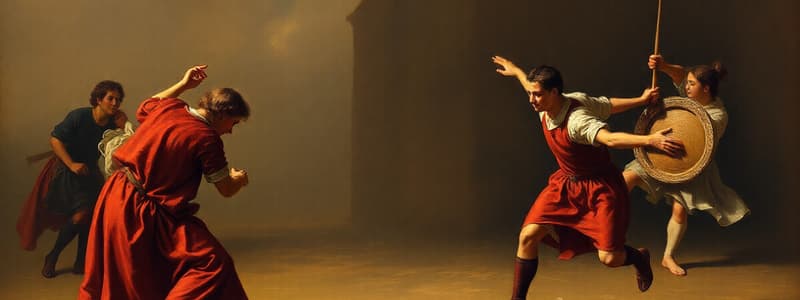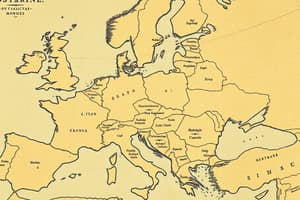Podcast
Questions and Answers
What was the primary focus of the initial training phase for young noblemen aspiring to become knights?
What was the primary focus of the initial training phase for young noblemen aspiring to become knights?
- Weapons practice
- Horse riding skills
- Military strategy
- Politeness and etiquette (correct)
Which of the following was a requirement for an aspirant to achieve knighthood?
Which of the following was a requirement for an aspirant to achieve knighthood?
- Ownership of a horse (correct)
- Completion of a religious pilgrimage
- Mastery of chivalric history
- Victory in a jousting match
During which age range did a boy transition from initial training to becoming a squire?
During which age range did a boy transition from initial training to becoming a squire?
- 20 to 25 years
- 6 to 12 years
- 16 to 20 years
- 12 to 16 years (correct)
What was required of an aspirant the night before their investiture ceremony?
What was required of an aspirant the night before their investiture ceremony?
What was the role of knights within the feudal system?
What was the role of knights within the feudal system?
The legal framework of chivalry in Spain was defined by which document?
The legal framework of chivalry in Spain was defined by which document?
What was a key characteristic associated with medieval knights?
What was a key characteristic associated with medieval knights?
At what stage did the education of a future knight primarily involve learning military strategy?
At what stage did the education of a future knight primarily involve learning military strategy?
What was the primary purpose of jousting in its early days?
What was the primary purpose of jousting in its early days?
Which of the following scores was awarded for knocking down an opponent during jousting?
Which of the following scores was awarded for knocking down an opponent during jousting?
What element was added to jousting to make it more structured and polite?
What element was added to jousting to make it more structured and polite?
In the context of jousting, what does the term 'Quintena' refer to?
In the context of jousting, what does the term 'Quintena' refer to?
Which action resulted in the deduction of points during a jousting competition?
Which action resulted in the deduction of points during a jousting competition?
What was one of the prizes awarded during a formal jousting event?
What was one of the prizes awarded during a formal jousting event?
What did the jousting scoring system deduct points for when hitting?
What did the jousting scoring system deduct points for when hitting?
What role did 'Bohordos' play in jousting tournaments?
What role did 'Bohordos' play in jousting tournaments?
What contributed to the decline of physical and sporting activity during the Middle Ages?
What contributed to the decline of physical and sporting activity during the Middle Ages?
What was seen as a more important pursuit than physical education during the Middle Ages?
What was seen as a more important pursuit than physical education during the Middle Ages?
How was physical education viewed in schools during the Middle Ages?
How was physical education viewed in schools during the Middle Ages?
What activities were integrated into popular festivals during the Middle Ages?
What activities were integrated into popular festivals during the Middle Ages?
What new perspective of the human body emerged during the Middle Ages?
What new perspective of the human body emerged during the Middle Ages?
Which aspect was NOT a reason for the decline in sporting activities during the Middle Ages?
Which aspect was NOT a reason for the decline in sporting activities during the Middle Ages?
What type of events were allowed during agricultural celebrations in the Middle Ages?
What type of events were allowed during agricultural celebrations in the Middle Ages?
What did the Catholic opposition during the Middle Ages emphasize regarding sports?
What did the Catholic opposition during the Middle Ages emphasize regarding sports?
Flashcards
Sports in the Middle Ages?
Sports in the Middle Ages?
The Middle Ages saw a decline in physical activity compared to the Roman Empire.
Catholic opposition to Roman sports
Catholic opposition to Roman sports
The Catholic Church discouraged physical activity in favor of spiritual pursuits.
New concept of the human body
New concept of the human body
The Middle Ages saw a shift in how people viewed the body, considering it a burden for the soul.
Physical education in schools
Physical education in schools
Signup and view all the flashcards
Body culture in the Middle Ages
Body culture in the Middle Ages
Signup and view all the flashcards
Sports and manual labor
Sports and manual labor
Signup and view all the flashcards
Types of competitions
Types of competitions
Signup and view all the flashcards
Formal physical education
Formal physical education
Signup and view all the flashcards
Chivalry Education
Chivalry Education
Signup and view all the flashcards
Initial Training
Initial Training
Signup and view all the flashcards
Squire
Squire
Signup and view all the flashcards
Knighthood
Knighthood
Signup and view all the flashcards
The Ideal of Chivalry
The Ideal of Chivalry
Signup and view all the flashcards
Bellatores
Bellatores
Signup and view all the flashcards
Laws of the Seven Partidas
Laws of the Seven Partidas
Signup and view all the flashcards
Jousting
Jousting
Signup and view all the flashcards
Early Jousting
Early Jousting
Signup and view all the flashcards
Polite Jousting
Polite Jousting
Signup and view all the flashcards
Ground Combat
Ground Combat
Signup and view all the flashcards
Jousting Scoring
Jousting Scoring
Signup and view all the flashcards
Rings Test
Rings Test
Signup and view all the flashcards
Bohordos
Bohordos
Signup and view all the flashcards
Quintena
Quintena
Signup and view all the flashcards
Study Notes
Early and Late Middle Ages Sport
- The Roman Empire divided in 395 AD, leading to a period spanning nearly a millennium (5th-15th centuries).
- This period was marked by political and territorial instability.
- Frequent wars of conquest and expansion were common.
- Alliances between kingdoms were forged.
Historical Introduction (High Middle Ages)
- Germanic invasions led to the fall of Roman structures.
- Insecurity, violence, and constant warfare characterized this period.
- Agricultural society was important, with land ownership pivotal.
- Viking invasions around 1000 AD led to feudalism.
- Rural and subsistence economies were dominant.
- The Church and nobility played critical roles in social cohesion.
Historical Introduction (Low Middle Ages)
- Viking invasions ended, increasing security and leading to demographic growth.
- Cities became active economic centers.
- A new social class, the bourgeoisie, emerged.
- The 14th century saw conflicts like the Black Death, followed by a century-long recovery.
Physical Education in the Middle Ages
- Physical education was removed from schools.
- Body culture was mainly tied to festivals, especially those linked to agricultural cycles.
- Sporting activities were integrated into daily labor to improve morale (e.g., cutting logs).
- Strength competitions, such as weightlifting and wrestling, were permitted during festivals.
- Archery and other athletic events were common.
European Chivalry and its Physical and Sporting Activities
- Training to become a knight was exclusive to the nobility.
- Physical training was valued for military defense.
- Knight training comprised three phases: initial training, squirehood, and knighthood.
Tournaments
- Tournaments were prominent in the Middle Ages.
- These events simulated battles between knights in enclosed arenas.
- Tournaments often commemorated special occasions, mostly military ones.
- The early tournaments ('a mêlée') lacked rules, used real weapons, and were held in open fields.
- Later tournaments (polite tournaments) were more regulated, safer, and used non-injurious weapons.
- Detailed rules concerning weapons, formation, and locations were implemented.
Jousting
- Jousting involved knights on horseback charging each other with spears.
- Jousting evolved from brutal combats into a more regulated, chivalrous activity.
- Standardized scoring systems were introduced in the more polite jousts.
Equestrian Skill Tests
- Rings: a test requiring lance precision and speed while galloping.
- Bohordos: a simulated battle where riders try to dismount opponents.
- Quintena: a challenge involving hitting a spinning target with a lance.
Passage of Arms
- A voluntary chivalric activity where a knight would challenge any passing knight.
- Courtship was a common motivation for participating.
- Rules were agreed upon by knights to maintain fairness.
Trial by Combat (Duel)
- Disputes were resolved through duels fought to the death, often in specially designated arenas.
- Participants were required to have witnesses.
- This practice eventually declined in the 16th century.
Non-Chivalric Combat Sports
- This category includes various historical combat sports.
Ringen
- A form of German unarmed wrestling, prevalent during the Late Middle Ages and Renaissance.
- It involved grappling, joint locks, and kicks.
- The sport was recognized in military training and at public performances.
Schwingen
- A Swiss wrestling tradition.
- Primarily practised in alpine regions by shepherds.
- It occurs on a 12-meter-diameter ring.
- Leather shorts are crucial for executing specific wrestling techniques.
Cumberland and Westmoland Wrestling
- A traditional English wrestling style.
- Practised during local fairs.
- This style focused on fixed positions with wrestlers holding each other.
Scottish Backhold
- A Scottish wrestling style, often depicted in festivals and local markets
- Wrestlers stood face to face in the "backhold" position, using their arms around the opponent's waist or back.
Game of "ferir la pelota"
- A Spanish ball game.
- The depiction in the Spanish Cántigas de Santa Maria shows similar characteristics to baseball.
Jeu de Paume
- A sport of French origin, using wooden paddles.
- The sport is a predecessor of tennis and squash.
- The court design was characteristic of a rectangular walled structure, which made the game a significant physical activity.
Soule
- A ball game of French origin.
- It was a peasant or common folk sport.
- It was a community competition usually involving neighbouring towns.
Chess
- Chess was introduced to Europe from the Arab world.
- This game became popular in the Castilian court, promoted by Alfonso X "the Wise."
- Chessboards, dice games, and chess books served as records.
Bullfighting
- A popular sport in Iberian lands that originated during medieval times.
- Bullfighting rituals emerged from the marriage traditions
- The act of killing a bull was connected to fertility rites.
Studying That Suits You
Use AI to generate personalized quizzes and flashcards to suit your learning preferences.





